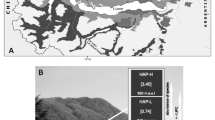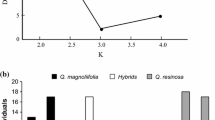Abstract
Three species of burdock (Arctium lappa, A. tomentosum, and A. minus; Asteraceae), which commonly occur in sympatry in Central Europe, are thought to hybridize frequently, hence raising questions about their integrity. We surveyed mixed, monotypic, and/or single plant stands of these species in Central Germany to assess their extent of hybridization and introgression, and also the likelihood of insect host shifts between them. Individual plants were characterized by multivariate analyses of morphological and RAPD variation in combination with RAPD-based character-index-scores. All analyses recognized the three species as distinct units, but also identified a limited number of first (or early) generation hybrids between sympatric A. lappa and either A. tomentosum or A. minus, respectively, as well as one introgressant of A. tomentosum into A. lappa. While pre-zygotic isolation may partly account for the rarity of first generation crosses (F1's), the near absence of later generation hybrid segregants or introgressants likely reflects post-zygotic isolation due to the disruption of co-adapted gene complexes and/or habitat-mediated superiority shared by the ruderal parentals. As the tephritid fly Tephritis bardanae oviposits on both A. tomentosum (T) and A. minus (M), but not on A. lappa (L), the occurrence of L × M and L × T hybrids and/or introgressants may have important evolutionary consequences regarding the acquisition of a new host, i.e. A. lappa, by these insects.
Similar content being viewed by others
References
Abbott R. J. (1992). Plant invasions, interspecific hybridization and the evolution of new plant taxa. Trends Ecol. Evol. 7: 401–405
Aldridge G. (2005). Variation in frequency of hybrids and spatial structure among Ipomopsis (Polemoniaceae) contact sites. New Phytol. 167: 279–288
Anderson E. (1949). Hybridization of the habitat. Evolution 2: 1–9
Arènes J. (1950). Monographie du genre Arctium L. Bull. Jardin Bot. l' Etat, Bruxelles 20: 67–156
Arnold M. L. (1997). Natural hybridization and evolution. Oxford University Press, New York
Barton N. H. and Hewitt G. M. (1989). Adaptation, speciation and hybrid zones. Nature 341: 497–503
Burgess K. S., Morgan M., Deverno L. and Husband C. (2005). Asymmetrical introgression between two Morus species (M. alba, M. rubra) that differ in abundance. Molec. Ecol. 14: 3471–3483
Comes H. P. and Abbott R. J. (2001). Molecular phylogeography, reticulation and lineage sorting in Mediterranean Senecio sect. Senecio (Asteraceae). Evolution 55: 1943–1962
Cozzolino S. and Widmer A. (2006). The evolutionary basis of reproductive isolation in Mediterranean orchids. Taxon 54: 977–985
Cruzan M. B. and Arnold M. L. (1993). Ecological and genetic associations in an Iris hybrid zone. Evolution 47: 1432–1445
Diegisser T., Johannesen J., Lehr C. and Seitz A. (2003). Genetic and morphological differentiation in Tephritis bardanae (Diptera: Tephritidae): evidence for host-race formation. J. Evol. Biol. 17: 83–93
Dobzhansky T. H. (1941). Genetics and the origin of species. Columbia University Press, New York, USA
Dodd R. and Afzal-Rafii Z. (2004). Selection and dispersal in a multispecies oak hybrid zone. Evolution 58: 261–269
Ducarme V. and Wesselingh R. A. (2005). Detecting hybridization in mixed populations of Rhinanthus minor and Rhinanthus angustifolius. Folia Geobot. 40: 151–161
Duistermaat H. (1996) Monograph of Arctium L. (Asteraceae): generic delimitation (including Cousinia Cass. p.p.), revision of the species, pollen morphology and hybrids. Rijksherbarium/Hortus Botanicus, Gorteria Supplement 3, Leiden, The Netherlands.
Dungey H. S., Potts B. M., Whitham T. G. and Li H.-F. (2000). Plant genetics affects arthropod community richness and composition: evidence from a synthetic eucalypt hybrid population. Evolution 54: 1938–1946
Emms S. K. and Arnold M. L. (1997). The effect of habitat on parental and hybrid fitness: transplant experiments with Louisiana irises. Evolution 51: 1112–1119
Floate K. and Whitham T. G. (1993). The “hybrid bridge” hypothesis: host shifting via plant hybrid swarms. Amer. Naturalist 141: 651–662
Fritz R. S., Nichols-Orians C. M. and Brunsfeld S. J. (1994). Interspecific hybridization of plants and resistance to herbivores: hypotheses, genetics, and variable responses in a diverse herbivore community. Oecologia 97: 106–117
Grant V. (1981). Plant speciation. Columbia University Press, New York
de Greef B. and Triest L. (1999). The use of random amplified polymorphic DNA (RAPD) for hybrid detection in Scirpus from the river Schelde (Belgium). Molec. Ecol. 8: 379–386
Gross R. S., Werner P. A. and Hawthorn W. R. (1980). The biology of Canadian weeds. 38. Arctium minus (Hill) Bernh. and A. lappa L. Canad. J. Pl. Sci. 60: 621–634
Hardig T. M., Brunsfeld S. J., Fritz R. S., Morgan M. and Orians C. M. (2000). Morphological and molecular evidence for hybridization and introgression in a willow (Salix) hybrid zone. Molec. Ecol. 9: 9–24
Harrison R. G. and Bogdanowicz S. M. (1997). Patterns of variation and linkage disequilibrium in a field cricket hybrid zone. Evolution 51: 493–505
Hegarty M. J. and Hiscock S. (2005). Hybrid speciation in plants: new insights from molecular studies. New Phytol. 165: 411–423
Hegi G. (1979). Illustrierte Flora von Mitteleuropa, Band 6. JF Lehmanns Verlag, Munich
Hewitt G. M. (1988). Hybrid zones – natural laboratories for evolutionary studies. Trends Ecol. Evol. 3: 158–167
Hewitt G. M., Nichols R. A. and Barton N. H. (1987). Homogamy in a hybrid zone in the alpine grasshopper Podisma pedestris. Heredity 59: 457–466
Howard D. J., Preszler R. W., Williams J., Fenchel S. and Boecklen W. J. (1997). How discrete are oak species? Insights from a hybrid zone between Quercus grisea and Quercus gambelii. Evolution 51: 747–755
Hultén E. and Fries M. (1986). Atlas of North European vascular plants. Koeltz Scientific Books, Königstein
Jiggins C. D. and Mallet J. (2000). Bimodal hybrid zones and speciation. Trends Ecol. Evol. 15: 250–255
Johnston J. A., Wesselingh R. A., Bouck A. C., Donovan L. A. and Arnold M. L. (2001). Intimately linked or hardly speaking? The relationship between genotype and environmental gradients in a Louisiana Iris hybrid population. Molec. Ecol. 10: 673–682
Kadereit J. W., Uribe-Convers S., Westberg E. and Comes H. P. (2006). Reciprocal hybridization at different times between Senecio flavus and Senecio glaucus gave rise to two polyploid species in north Africa and south-west Asia. New Phytol. 169: 431–441
Kerner von Marilaun A. (1875). Die Primulaceen-Bastarde der Alpen. Oesterr. Bot. Z. 25: 153–164
Khyos D. W., Clark C and Thompson W. C. (1981). The hybrid nature of Encelia laciniata (Compositae: Heliantheae) and control of population composition by post-dispersal selection. Syst. Bot. 6: 399–411
Lehr C. (1994) Populationsbiologische Untersuchungen an Tephritis bardanae Schrank (Diptera: Tephritidae). PhD thesis, University of Mainz, Germany.
Mallet J. (2005). Hybridization as an invasion of the genome. Trends Ecol. Evol. 20: 229–237
Marohasy J. (1996). Host shifts in biological weed control – real problems, semantic difficulties or poor science. Int. J. Pest Manage. 42: 71–75
Martin L. J. and Cruzan M. B. (1999). Patterns of hybridization in the Piriqueta caroliniana complex in Central Florida: evidence for an expanding hybrid zone. Evolution 53: 1037–1049
Mayr E. (1954). Change of genetic environment and evolution. In: Huxley, J., Hardy, A. C. and Ford, E. B. (eds) Evolution as a process, pp 157–180. Allen and Unwin, London
Milne R. I., Terzioglu S. and Abbott R. J. (2003). A hybrid zone dominated by fertile F1s: maintenance of species barriers in Rhododendron. Molec. Ecol. 12: 2719–2729
O'Hanlon P. C., Peakall R. and Briese D. T. (1999). AFLP reveals introgression in weedy Onopordum thistles: hybridization and invasion. Molec. Ecol. 8: 1239–1246
Nason J. D., Ellstrand N. C. and Arnold M. L. (1992). Patterns of hybridization and introgression in populations of oaks, manzanitas, and irises. Amer. J. Bot. 79: 101–111
Palopoli M. F. and Wu C.-I. (1996). Rapid evolution of co-adapted gene complexes: evidence from the segregation distorter (SD) system of meiotic drive in Drosophila melanogaster. Genetics 143: 1675–1688
Pilson D. (1999). Plant hybrid zones and insect host range expansion. Ecology 80: 407–415
Porter A. H. (1997). The Pieris napi/bryoniae hybrid zone at Pont de Nant, Switzerland: broad overlap in the range of suitable host plants. Ecol. Entomol. 22: 189–196
Pritchard J. K., Stephens M. and Donnelly P. (2000). Inference of population structure using mutinous genotype data. Genetics 155: 945–959
Ramsey J., Schemske D. W. and Bradshaw H. D. (2003). Components of reproductive isolation between the monkeyflowers Mimulus lewisii and M. cardinalis (Phrymaceae). Evolution 57: 1520–1534
Rieseberg L. H. (1996). Homology among RAPD fragments in interspecific comparisons. Molec. Ecol. 5: 9–105
Rieseberg L. H., Arias D. M., Ungerer M., Linden C. R. and Sinervo B. (1996). The effects of mating design on introgression between chromosomally divergent sunflower species. Theor. Appl. Genet. 93: 633–644
Rieseberg L. H. and Carney S. C. (1998). Hybrid origin of plant species. Annual Rev. Ecol. Syst. 28: 359–389
Rieseberg L. H. and Ellstrand N. C. (1993). What can morphological and molecular markers tell us about plant hybridization. Crit. Rev. Pl. Sci. 12: 213–241
Rieseberg L. H. and Linder C. R. (1999). Hybrid classification: insights from genetic map-based studies of experimental hybrids. Ecology 80: 361–370
Rieseberg L. H., Raymond O., Rosenthal D. M., Lai Z., Livingstone K., Nakazato T., Durphy J. L., Schwarzbach A. E., Donovan L. A. and Lexer C. (2003). Major ecological transitions in wild sunflowers facilitated by hybridization. Science 301: 1211–1216
Rieseberg L. H., Whitton J. and Gardner K. (1999). Hybrid zones and the genetic architecture of a barrier to gene flow between two sunflower species. Genetics 152: 713–727
Rohlf F. J. (1990). NTSYS-pc: numerical taxonomy and multivariate analysis system, Version 1.60. Exeter Software, New York
Rollo C. D., MacFarlane J. D. and Smith B. S. (1985). Electrophoretic and allometric variation in burdock (Arctium spp.): hybridization and its ecological implications. Canad. J. Bot. 63: 1255–1261
Senghas K. and Seybold S. (1993). Schmeil Fitschen, Flora von Deutschland. Quelle and Meyer, Heidelberg
Stace C. A. (1997). The new flora of the British Isles. 2nd ed. Cambridge University Press, Cambridge
StatSoft Inc. (2004) STATISTICA (Data Analysis Software System). StatSoft, Tulsa, USA.
Stebbins G. L. (1959). The role of hybridization in evolution. Proc. Amer. Phil. Soc. 103: 231–251
Stephens S. G. (1949). The cytogenetics of speciation in Gossypium. I. Selective elimination of the donor parent genotype in interspecific backcrosses. Genetics 34: 627–637
Susanna A., Garcia-Jacas N., Vilatersana R. and Garnatje T. (2003). Generic boundaries and evolution of characters in the Arctium group: a nuclear and chloroplast DNA analysis. Collect. Bot. 26: 101–118
Voggesberger M. (1996). Arctium L. In: Sebald, O., Seybold, S., Philippi, G. and Wörz, A. (eds) Die Farn- und Blütenpflanzen Baden-Württembergs: Spezieller Teil (Spermatophyta, Unterklasse Asteridae), Bd. 6, pp 233–239. Eugen Ulmer, Stuttgart
Whitham T. G., Morrow P. A. and Potts B. M. (1994). Plant hybrid zones as centers of biodiversity: the herbivore community of two endemic Tasmanian eucalypts. Oecologia 97: 481–490
Author information
Authors and Affiliations
Corresponding author
Rights and permissions
About this article
Cite this article
Repplinger, M., Johannesen, J., Seitz, A. et al. Morphological and molecular evidence for hybridization and introgression in Central European Arctium (Asteraceae). Plant Syst. Evol. 268, 75–95 (2007). https://doi.org/10.1007/s00606-007-0547-9
Received:
Accepted:
Published:
Issue Date:
DOI: https://doi.org/10.1007/s00606-007-0547-9




